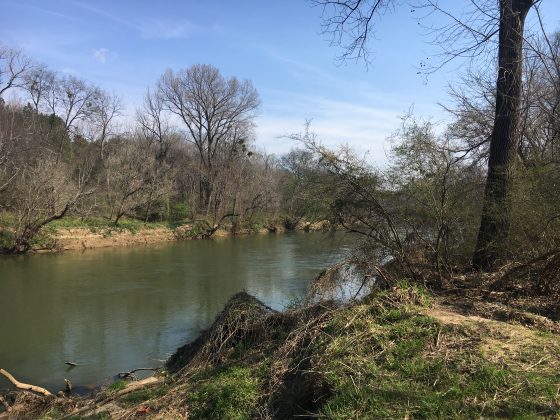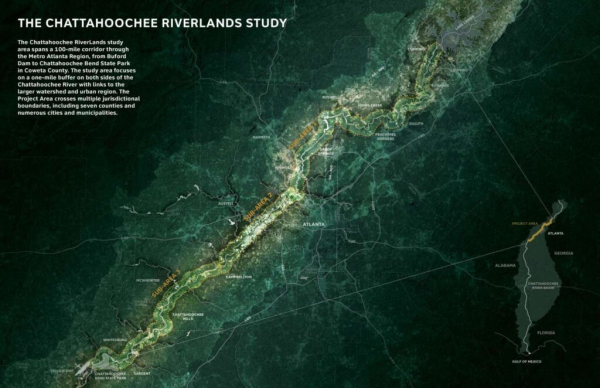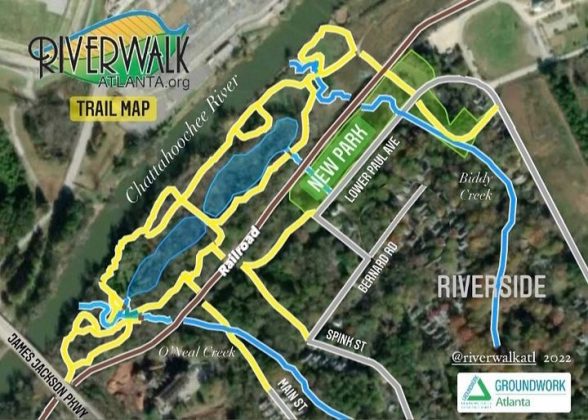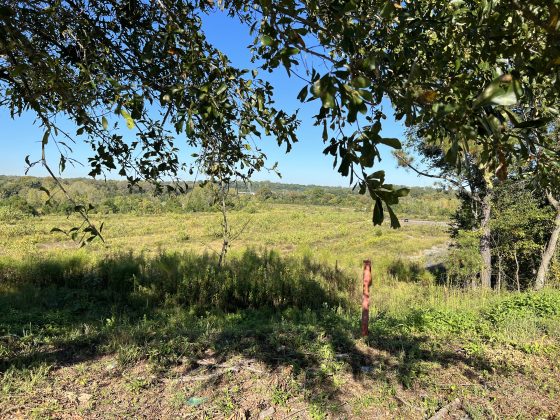Restoring the Riverfront: How trail and park Creation in Atlanta Benefits Health

Flowing 430 miles from northern Georgia to the Florida panhandle, the Chattahoochee River is one of the most defining features in Atlanta. North and south of the city, the riverfront is lined by a series of parks and trails, but inside the borders of Atlanta, the riverfront becomes inaccessible. The banks of the river are occupied by private property, industrial land – including a water reclamation site, a concrete manufacturer, and a landfill – and vacant lots with different levels of contamination. As of now, there are no public access points along the river within Atlanta’s jurisdiction.
This is not only an urban and suburban inequity, but there are vast differences in access across different neighborhoods in the city. Atlanta, GA scores just 48% on the Trust for Public Land’s 2022 ParkScore Equity Index, meaning that “residents living in neighborhoods of color have access to 48% less nearby park space than those living in white neighborhoods and residents living in lower-income neighborhoods have access to 33% less nearby park space than those in higher-income neighborhoods.”
The implications of these differences can be felt in nearly every aspect of daily life. The distribution of park space has immediate implications on who has access to outdoor recreation, which communities have shade, and where flooding occurs most frequently. But, there are also more insidious implications.
Access to green spaces is a critical component of our physical and mental health, especially in urban environments, which are often characterized by high-density infrastructure, air and noise pollution, and limited access to nature. Outdoor spaces like parks and greenways provide ecosystem services, like air purification, flood control, and temperature regulation, while creating opportunities for recreation, physical activity, and social connection. Green spaces have also been shown to have enormous mental health benefits, including reducing stress, depression, and anxiety, and improving cognition in children and adults.
In collaboration with the Trust for Public Land (TPL) and the City of Atlanta, Groundwork Atlanta is on a mission to reclaim the riverfront, increase access to the outdoors, and improve public health across the city.
Reclaiming the Riverfront | The Chattahoochee RiverLands Initiative

While discussions about the possibility of repurposing the riverfront began more than three decades ago, the vision gained traction over the past few years with the completion of the TPL-led Chattahoochee RiverLands study, which developed a plan for constructing a 100-mile, multi-use greenway connecting 19 cities across seven counties in Georgia. Completion of the riverfront activation initiative will restore floodplains and brownfields, and create a continuous network of trails, green spaces, parks, and water access points along the Chattahoochee for public use.
As part of this ambitious project, Groundwork Atlanta has joined with a coalition to help pave the way for five miles of new trails and park space within the city limits of Atlanta. Due to the currently disjointed ownership along the river, bringing this vision to life requires coordinating across multiple stakeholders and working plot-by-plot to reclaim, remediate, and activate the land.

Before breaking ground, the City of Atlanta is carrying out a planning study to determine the scale of the project and mapping out the opportunities to:
- Reclaim vacant land and empty lots.
- Assess, remediate, and purchase former industrial land to connect to the greenway.
- Collaborate with landowners to connect private property along the trails.
It really is an unbelievable opportunity right now, and that’s why Groundwork Atlanta is working with these partners to jump on it,” – Executive Director of Groundwork Atlanta, Heather Hussey-Coker.
One of the key sites along the five miles of Atlanta riverfront is the former Chattahoochee Brick Company, which used prison labor in the late 19th and early 20th centuries to manufacture the bricks that are the foundation of roads and buildings across much of the city today. After more than five years leading the opposition to plans to build a fuel terminal on this ecologically fragile and historically significant site, Groundwork Atlanta engaged the Southern Environmental Law Center to collectively develop a legal strategy for the City, which led to the property owner’s abandonment of the fuel terminal plans. The Conservation Fund, on behalf of the City of Atlanta, was able to purchase the 75-acre site to add to the public green space along the riverfront and pay tribute to those who were unjustly forced to work on the site.

why it matters
Given the current inaccessibility of the Chattahoochee Riverfront for most Atlantans, the benefits of the RiverLands project cannot be overstated. Here are a few ways it will improve the quality of life for city residents:

Reduce flooding.
One of the primary goals of this initiative is to rebuild the floodplain along the river to protect communities from more frequent flooding. “All of Atlanta gets its water from the Chattahoochee River. So our first priority is protecting this land, cleaning it up, and restoring it as park space or doing a full riverbank restoration,” Heather said. Not only will the floodplain manage stormwater more effectively, but it will also improve water quality by preventing sewer overflows and subsequent pathogen and mosquito breakouts that occur with regular flooding.
Improve air quality.
The area surrounding the Chattahoochee Riverfront has poor local air quality due to particulate matter emitted from trucks and cars on nearby Interstate Highway 285 and Plant McDonough, operated by Georgia Power. Plans are being made to add a lane that expands the highway to accommodate more cars during rush hour, making the riverfront trail network even more important. The RiverLands greenway, when constructed, will provide alternative transportation opportunities to residents, reducing the number of local car trips.
Mitigate heat.
The RiverLands initiative serves as a launchpad for Atlanta to think about how it wants to grow and preserve its forests and green spaces, which will help improve local air quality by filtering pollutants and reduce the urban heat island effect through shade and evapotranspiration.
Boost mental and physical health.
Creating accessible public green spaces along the riverfront allows for outdoor activities like kayaking, hiking, and picnicking, which can improve physical health and provide an opportunity for residents to reap the mental health benefits of being in nature, such as reducing stress, anxiety, and depression, and improving overall mood and well-being.
By bettering air and water quality, reducing the impacts of climate change through heat and flood mitigation, and providing recreation and activity spaces, the RiverLands initiative is the ultimate self-care package for the community’s physical, mental, and social well-being.
To learn more, visit Groundwork Atlanta.
